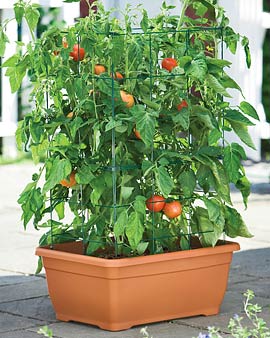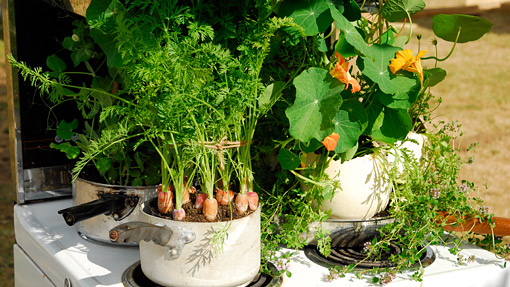As more of us find ourselves living in apartments or condos or town houses with no space for a vegetable garden, growing some veggies in containers becomes very attractive. Here in Yardener.com we have a major section on growing plants in containers which deals with important issues such as the container itself, the soil mix, and other key issues. For that general overview go to our Container Section.
You Can Grow A Bunch Of Veggies In Containers
 Most vegetables are easy to grow in containers IF you have a proper sized container and IF you pay attention to watering and fertilizing. Containers can be quick to have a terrible environment for growing tomatoes. They dry out faster than does the soil in the garden. Because there is less space for vegetable plant roots, frequent fertilizing is required to compensate. Cheat on the water and fertilizer and you may as well not go to the trouble.
Most vegetables are easy to grow in containers IF you have a proper sized container and IF you pay attention to watering and fertilizing. Containers can be quick to have a terrible environment for growing tomatoes. They dry out faster than does the soil in the garden. Because there is less space for vegetable plant roots, frequent fertilizing is required to compensate. Cheat on the water and fertilizer and you may as well not go to the trouble.
Size of Container
A container for growing most vegetables must be at the very least 12 inches deep; of course with holes in the bottom. A container 18 inches deep or deeper is preferable and more likely to produce a nice crop of tomatoes. Vegetables such as lettuce, radish, and beets can grow in a container that is only six inches deep. Each vegetable file here in yardener.com will indicate the best container size for that vegetable.
 I've seen a whole vegetable garden in the middle of a street of row houses in Philadelphia with all manner of vegetable growing in those plastic milk bottle crates you see at grocery stores. The containers were on the porch, on the porch roof, and even on the garage roof. As long as the container has drain holes and is big enough to support the vegetable plant, almost anything goes.
I've seen a whole vegetable garden in the middle of a street of row houses in Philadelphia with all manner of vegetable growing in those plastic milk bottle crates you see at grocery stores. The containers were on the porch, on the porch roof, and even on the garage roof. As long as the container has drain holes and is big enough to support the vegetable plant, almost anything goes.
Potting Mix
Use no real soil in a container growing vegetables. Use a quality soilless potting mix from the garden center. Many vegetables are very sensitive to uneven water availability. A good potting mix will retain water sufficiently so you usually don’t have to water every day. See potting mixes in Yardener's Tool Shed; click here.
Fertilizer For Vegetables In Containers
We recommend using a liquid organic fertilizer that is mixed with the water given to the tomato in a container. Because most containers are too small to allow for full growth of a plant’s roots, frequent fertilizing is necessary. We usually add a tablespoon of liquid fertilizer every time we water which can be daily when the plants are mature and producing fruit. See liquid organic fertilizers in Yardener's Tool Shed; click here.
Continuous Watering Containers For Vegetables
There are a number of continuous watering containers that work well with almost all vegetables. Perhaps the most popular is the EARTHBOX which has a reservoir that holds 3 gallons of water. It holds 2 cubic feet of growing media which is enough for growing several plants. The Earthbox offers an optional trellis that is really essential if you are growing tomatoes, peppers, and cucumbers.

